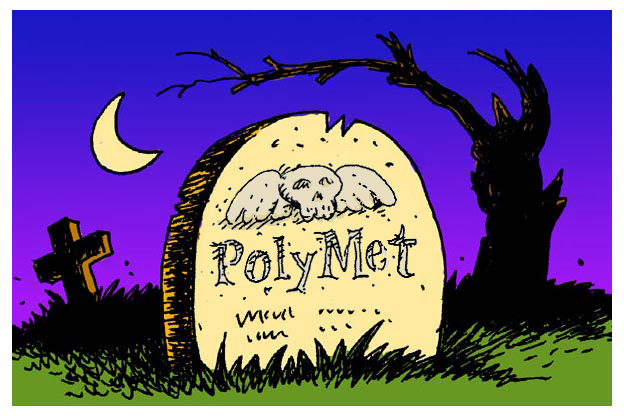

Who will keep PolyMet’s grave clean?
Because it sure won’t be PolyMet
There was an article in the Strib and one in the Duluth Tribune on October 5th about the perpetual care that a PolyMet open pit sulfide mine would require after it closed, filtering water runoff from the site for 500 years. This should sober you, kids, or maybe your kids’ kids’ kids’ kid’s kids. But since they are not here yet, it is up to you to look after them.
I’ve written many stories about sulfide mining. Here’s a current list; well, current up until today, anyway.
Here’s the lede from the Strib story:
A proposed copper-nickel mine in northeast Minnesota would generate water pollution for up to 500 years and require billions of dollars in long-term cleanup costs, state regulators have concluded as they near a key stage in the project’s review.
That’s billions with a “B.” Here’s more from the article about PolyMet’s draft environmental statement:
The DNR says in the environmental review that PolyMet would be required to operate the reverse osmosis water treatment systems for as long as necessary. PolyMet would also work on developing so-called passive water treatment systems, typically wetlands or other natural features, that at some point could replace the water treatment plants.
Computer projections in the environmental impact statement say that either active or passive water treatment will be needed for 200 years for the mine site, and up to 500 years for the metallurgical site. The document says water treatment would cost between $3.5 and $6 million per year after the mine closes.
“While long term,” the document reads, “These time frames for water treatment are not necessarily perpetual.”
“Not necessarily perpetual?” That’s over twice as long as it’s been since we sued King George for divorce. Heck, we’d barely started stealing the place from the Indians 500 years ago. It’s close enough to perpetual for me. And you don’t suppose PolyMet’s “computer projections” low balled the estimates, do you? Those darn computers are always so optimistic! And I’d confess to being leery of anybody who said that 500 years was “not necessarily perpetual.”
Let us assume for a moment that PolyMet manages against the odds — and they are really long odds — to contain all the sulphuric acid that it produces during mine operation. What happens when the mine closes?
“Well, we run the pumps for 500 years, of course,” says PolyMet. [hysterical laughter]
Just imagine it, kids, in the year 2540, PolyMet is still standing by, guarding the water supply! The fidelity is inspiring.
It is far more likely, though, that after mine is played out and it’s no longer producing any revenue, and a little while after that, PolyMet, or its practical parent corporation, Glencore Plc., a charming international mining consortium started by Marc Rich, will tire of pumping water and will just abandon the mine. We have a name for orphan mines like this — and there are many of them around the country — Superfund sites. That when our kids’ kids’ kids’ kids’ kid’s kids — or maybe just our kids — get a new name, too: stuckees.
The Strib article tells us about this:
Hard rock mines have a long history of environmental damage, according to the EPA. Agency documents show that sulfide rock mining of various kinds have polluted 10,000 miles of rivers and streams, mostly in the western United States. Between 1998 and 2007, the federal government spent at least $2.6 billion to clean up polluted hard-rock mines, some of which are now Superfund sites.
The Duluth Tribune reports about one of them:
[C]ritics of any copper mine that requires perpetual treatment say there are far more examples of copper mines that have gone horribly bad, often after the company has left town, leaving residents and taxpayers to foot the cleanup bill.
For most of the 20th century, until 1993, a Canadian company operated the Formosa copper and zinc mine near Riddle, Ore. The company abandoned the site in 1994. Within a few years, the mitigation system left behind intended to contain polluted runoff began to fail. State officials said that, since then, 18 miles of river have been heavily polluted by copper, cadmium, lead and zinc that “severely harmed the ecosystem of these streams, including protected coho and steelhead salmon populations.”
And LeftMN featured another one, the Barite Hill mine in South Carolina that went from first shovel in the ground to Superfund site in eighteen years which, I will admit, is fast work, even for a mining company.
At a recent presentation on PolyMet’s proposal, I asked Executive VP Brad Moore — one of those revolving-door-regulator-to-regulated types you hear so much about — whether the State of Minnesota should get Glencore’s guaranty of PolyMet’s environmental obligations. Bankers will tell you there is nothing like a cheerful guarantor to make one feel secure about a project.
Moore replied, “Oh, you don’t want that.”
Brad, I think we do.
Update: Commenter Joe observes:
Thanks for the update. It is totally illogical that this is happening. There is no upside. If these corporations think there is, they are self-deluded. Ya know, there is a just an incredible amount to bizarre illogical thinking going on in our world. But anyway, thanks.
The upside for the corporations comes if they can extract the metal without paying the true cost of getting it. The environmental degradation and clean up costs are massive externalities to the extraction business. “Externalities” means “somebody else pays.”
Thanks for your feedback. If we like what you have to say, it may appear in a future post of reader reactions.

